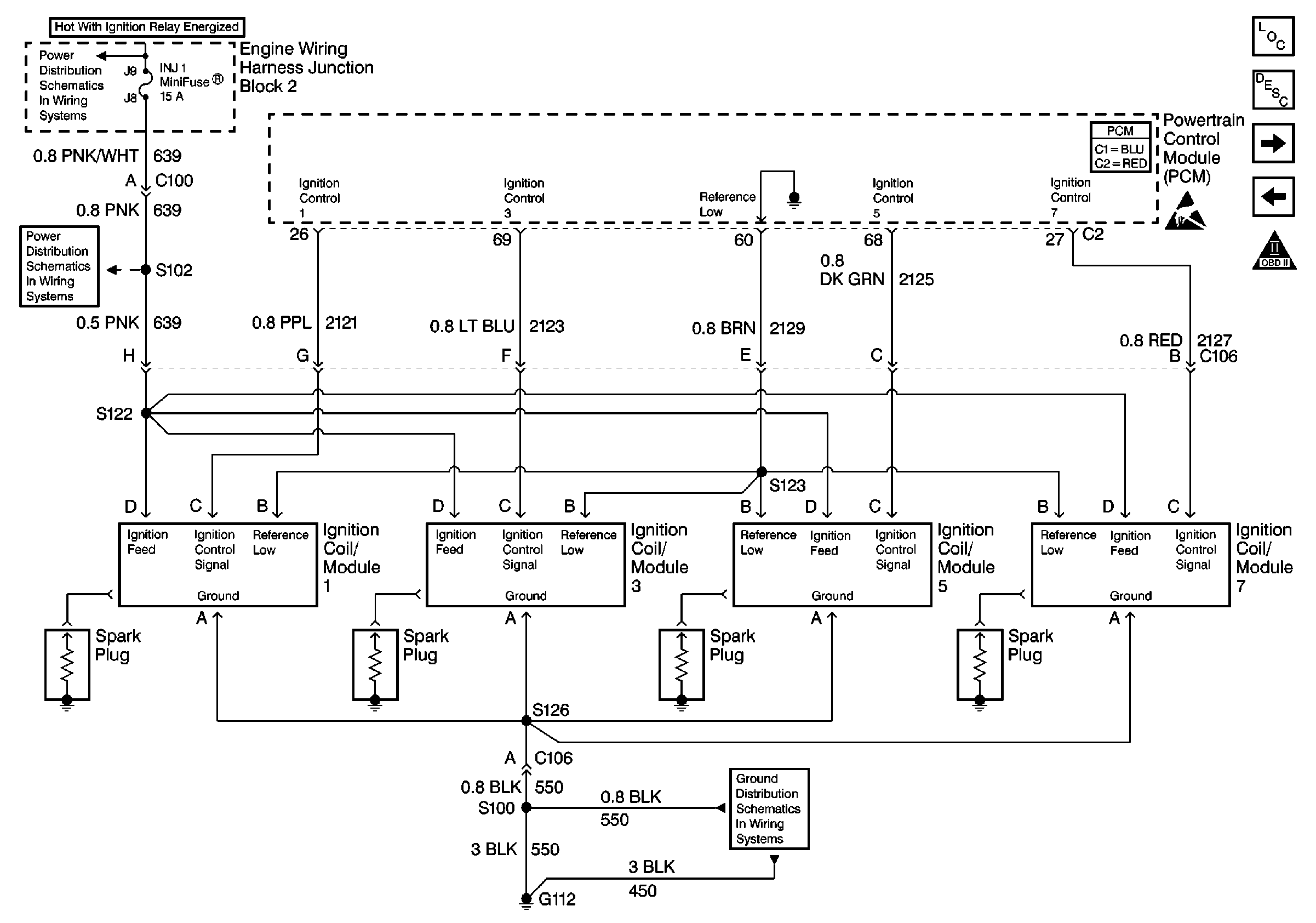Circuit Description
The electronic ignition system uses an individual ignition coil for each cylinder. The powertrain control module (PCM) controls the ignition operation through eight individual ignition control (IC) circuits. Each bank of four ignition coils is connected to the PCM, power, or ground by the following circuits:
| • | Low reference |
| • | Chassis ground |
| • | Ignition 1 voltage |
| • | The appropriate IC circuit |
The PCM triggers an ignition coil by grounding the appropriate IC circuit using information from the crankshaft position (CKP) and camshaft position (CMP) sensors.
Diagnostic Aids
Important:
• Remove any debris from the PCM connector surfaces before servicing
the PCM. Inspect the PCM connector gaskets when diagnosing/replacing the PCM.
Ensure that the gaskets are installed correctly. The gaskets
prevent water intrusion into the PCM. • For any test that requires probing the PCM or component harness
connectors, use the Connector Test Adapter Kit . Using this kit prevents
any damage to the harness connector terminals. Refer to in
Wiring Systems.
Using Freeze Frame/Failure Records data may aid in locating an intermittent condition. If you cannot duplicate the condition, the information included in the Freeze Frame/Failure Records data can help determine how many miles since the condition occurred. Operate vehicle within the same freeze frame conditions, including the RPM, the load, the vehicle speed, and the temperature that you observed. This will isolate when the condition occurred.
For an intermittent condition, refer to Intermittent Conditions .
Test Description
The numbers below refer to the step numbers on the diagnostic table.
-
Monitoring the Misfire Current Counters determines if a fault is present.
-
A good indication that the fuse is open is more than 2 of the Misfire Current Counters incrementing on one side of the engine. Inspect the ignition 1 voltage circuit for a grounded circuit.
-
If the fuse is open and no condition can be found with the ignition coil/module circuits, inspect the injector circuits for being grounded.
Step | Action | Yes | No |
|---|---|---|---|
Schematic Reference:
| |||
1 | Did you perform the Diagnostic System Check-Engine Controls? | Go to Step 2 | |
2 | Are DTCs P0200, P0300, P0335, P0336, P0351-P0358 set? | Go to Step 3 | |
Do any of the Misfire Current counters increment? | Go to Step 4 | Go to Intermittent Conditions | |
Do the Misfire Current Counters increment for 2 or more cylinders on one bank of the engine? | Go to Step 8 | Go to Step 5 | |
5 |
Does the test lamp illuminate? | Go to Step 6 | Go to Step 10 |
6 | Using the test lamp probe the ignition 1 voltage circuit at the ignition coil or electrical connector to the ignition coil ground circuit. Does the test lamp illuminate? | Go to Step 7 | Go to Step 13 |
7 | Using the test lamp probe the ignition 1 voltage circuit at the ignition coil electrical connector to the ignition coil low reference circuit. Does the test lamp illuminate? | Go to Step 21 | Go to Step 17 |
Did you find and correct the condition? | Go to Step 23 | Go to Step 9 | |
9 | Repair the open in the ignition 1 voltage circuit between the fuse block and the splice. Refer to Wiring Repairs in Wiring Systems. Did you complete the repair? | Go to Step 23 | -- |
10 |
Does the test lamp illuminate? | Go to Step 11 | Go to Step 12 |
11 | Repair the open circuit between the main 8-way harness connector and the ignition coil connector. Refer to Wiring Repairs in Wiring Systems. Did you complete the repair? | Go to Step 23 | -- |
12 | Repair the open ignition 1 voltage circuit between the fuse block and the main ignition coil 8-way harness connector. Refer to Wiring Repairs in Wiring Systems. Did you complete the repair? | Go to Step 23 | -- |
13 |
Does the test lamp illuminate? | Go to Step 14 | Go to Step 16 |
14 |
Did you find and correct the condition? | Go to Step 23 | Go to Step 15 |
15 | Repair the open ground circuit between the main 8-way connector and the ignition coil connector. Refer to Wiring Repairs in Wiring Systems. Did you complete the repair? | Go to Step 23 | -- |
16 | Repair the open ground circuit between the ground and the main 8-way connector. Refer to Wiring Repairs in Wiring Systems. Did you complete the repair? | Go to Step 23 | -- |
17 |
Does the test lamp illuminate? | Go to Step 18 | Go to Step 20 |
18 |
Did you find and correct the condition? | Go to Step 23 | Go to Step 19 |
19 | Repair the open low reference circuit between the main 8-way connector and the ignition coil connector. Refer to Wiring Repairs in Wiring Systems. Did you complete the repair? | Go to Step 23 | -- |
20 | Repair the open low reference circuit between the PCM and the splice. Refer to Wiring Repairs in Wiring Systems. Did you complete the repair? | Go to Step 23 | -- |
21 |
Did you find and correct the condition? | Go to Step 23 | Go to Step 22 |
22 | Replace ignition coil. Refer to Ignition Coil Replacement . Did you complete the replacement? | Go to Step 23 | -- |
23 |
Does the vehicle operate normally with no MIL illumination and no stored DTCs? | System OK | |

